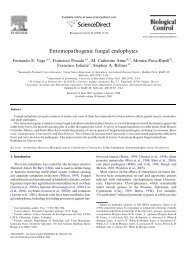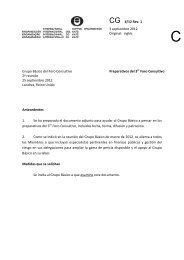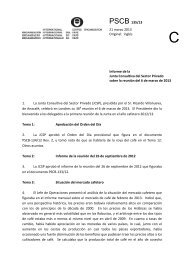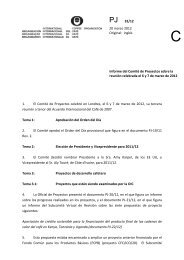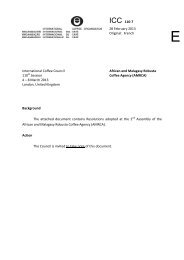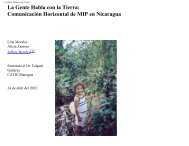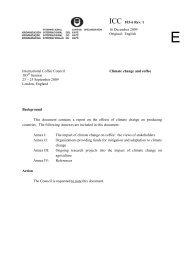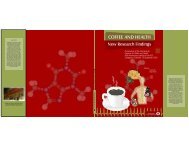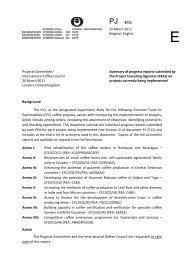Devouring profit - International Coffee Organization
Devouring profit - International Coffee Organization
Devouring profit - International Coffee Organization
Create successful ePaper yourself
Turn your PDF publications into a flip-book with our unique Google optimized e-Paper software.
60<br />
For the same percentage of CBB the potential economic losses are obviously much<br />
higher when the farms have intensive rather than traditional production systems. Because<br />
of greater potential losses they may thus resort to too many control activities,<br />
especially excessive spraying.<br />
Figure 13 shows for instance the case of a coffee farm with a productivity of 80<br />
arrobas/ha, where levels of 20% of CBB in the parchment coffee would present losses<br />
of about USD$145/ha. For the same level of CBB but on a farm producing 200 arrobas/<br />
ha, the loss would correspond to USD$484/ha.<br />
Loss in USD/ha/year<br />
532<br />
443<br />
355<br />
266<br />
177<br />
87<br />
0<br />
1% 4% 7% 10% 13% 16% 19%<br />
(%) Infestation level<br />
<strong>Coffee</strong><br />
Productivity<br />
80 @/ha/year<br />
120 @/ha/year<br />
160 @/ha/year<br />
200 @/ha/year<br />
Figure 13. Potential economic losses due to CBB for different productivities.<br />
5.5.2 CBB management costs<br />
Since CBB management can vary widely between farms, Cenicafé has developed a<br />
theoretical model that analyses these costs. Two assumptions are made, firstly the cost<br />
of the management can vary depending on the age of the coffee plot and secondly,<br />
the coffee plantation should be split into five plots with ages of between 1 and 5<br />
years, corresponding to the recommended 5 year life cycle of the crop in Colombia.<br />
Table 25 describes the pattern (Duque, 2001).<br />
The model additionally assumes intensive control of CBB which would only be justified<br />
in cases of severe attacks. It further assumes that the cost of the IPM strategy<br />
during the first two years of the plantation is very low and that as the plot ages the<br />
costs markedly increase.<br />
From the costs presented in the table those corresponding to cultural control should<br />
be considered as fixed costs of CBB control and therefore should be executed independently<br />
of the infestation level. However the other costs (biological, chemical, etc.)




